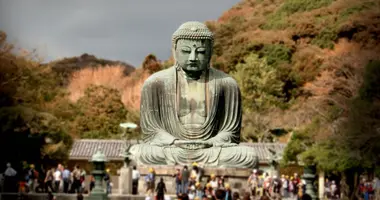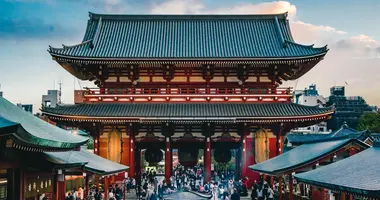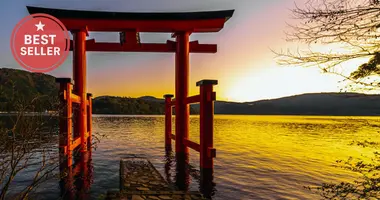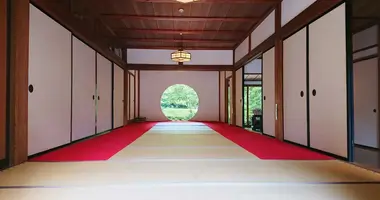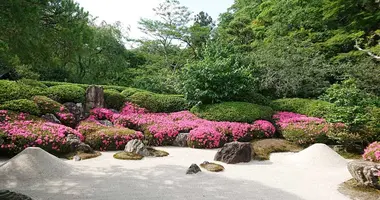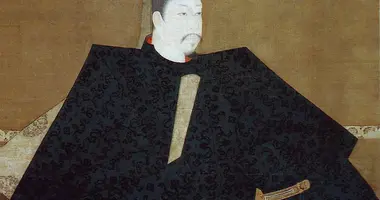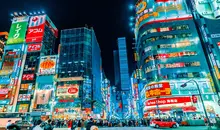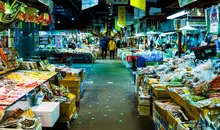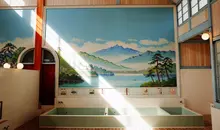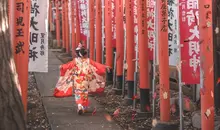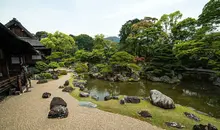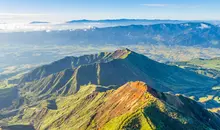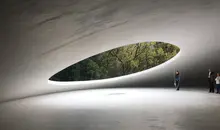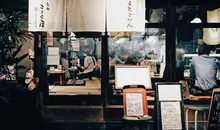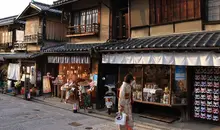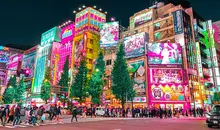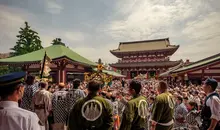Engakuji Temple Kamakura
- Published on : 10/07/2024
- by : Japan Experience
- Youtube
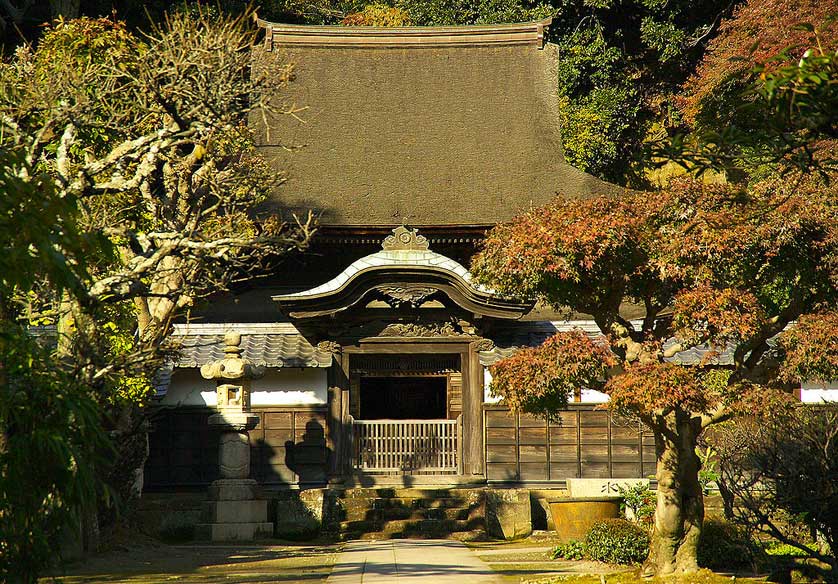
The Shariden, a National Treasure, contains a tooth of the Buddha, Engakuji Temple, Kamakura, Kanagawa Prefecture
Nestled in the historic city of Kamakura, Engakuji Temple stands as a testament to Japan's rich spiritual heritage. Founded in 1282, this venerable Zen Buddhist temple is not only a place of serene contemplation but also a guardian of Japanese history and culture. As you approach the temple grounds, you'll be greeted by the sight of ancient buildings seamlessly blending with the lush natural surroundings. The air is filled with a palpable sense of tranquility, inviting visitors to step back in time and experience the profound wisdom of Zen. Whether you're a spiritual seeker, a history enthusiast, or simply looking for a peaceful retreat, Engakuji offers a unique journey into the heart of Japanese Buddhism.
History and significance of Engakuji Temple
Engakuji Temple was founded in 1282 by the ruling regent Hojo Tokimune, following the repulsion of the Mongol invasions of Japan. The temple's establishment served a dual purpose: to honor the fallen soldiers from both sides of the conflict and to spread the teachings of Zen Buddhism. As one of Kamakura's Five Great Zen Temples, Engakuji quickly rose to prominence, becoming a center for Zen study and practice.
The temple's fortunes have ebbed and flowed over the centuries, mirroring the tumultuous history of Japan itself. During the Kamakura Period of Japanese history, Engakuji played a crucial role in the spread of Zen Buddhism among the samurai class. The teachings resonated deeply with the warrior ethos, emphasizing discipline, mindfulness, and decisive action. In fact, the temple grounds once included facilities for martial arts training, reflecting the holistic approach to developing both mind and body.
In the Meiji era, Engakuji became the chief center for Zen instruction in the Kanto region, solidifying its importance in Japanese Buddhism. Today, it continues to be a vital institution, offering zazen meditation sessions and other spiritual practices to both monks and lay practitioners.
Architecture and layout of the temple complex
Engakuji's architecture exemplifies the classical Japanese Zen monastic design, with buildings arranged in a straight line according to the perpendicular Zen style. As you enter the temple grounds, you'll notice how the austere buildings harmoniously blend with the wooded hillside, creating a serene and contemplative atmosphere.
The temple complex comprises 18 temples, each with its own unique features and significance. The layout follows the traditional Chinese-style architecture known as kara-yo or Zenshu-yo, introduced to Japan during the Kamakura period. This style is characterized by its simplicity and functionality, reflecting the Zen principles of minimalism and focus.
One of the most striking features of Engakuji is the Sanmon, or main gate, which dates back to 1783. This impressive two-story structure serves as the formal entrance to the temple complex, symbolically separating the secular world from the sacred space within. As you pass through the Sanmon, you'll find yourself on a path that leads to the various buildings of the temple, each one revealing a different aspect of Zen Buddhist practice and history.
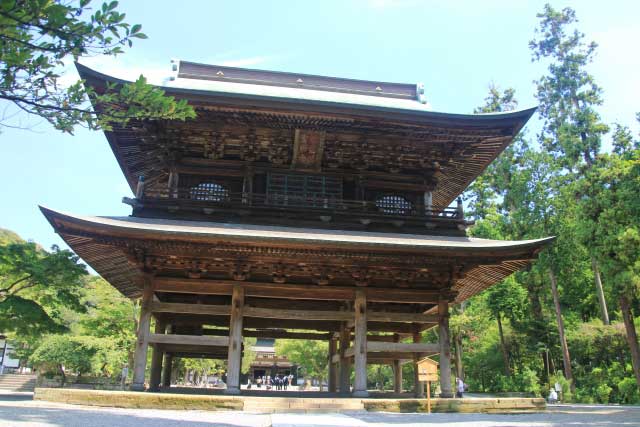
Sanmon Gate, Engakuji Temple, Kamakura, Kanagawa Prefecture
Notable buildings and treasures
Engakuji houses several important structures and artifacts, some of which have been designated as National Treasures or Important Cultural Properties. Among the most significant are:
- The Shariden (舎利殿): This reliquary hall is one of only two buildings in Kanagawa Prefecture designated as a National Treasure. It houses what is believed to be a tooth of the Buddha, gifted to Japan by China. The Shariden's architectural style dates back to the Muromachi period and is a prime example of kara-yo (Chinese-style) architecture.
- The Ogane (大鐘): This Great Bell, cast in 1301, is also designated as a National Treasure. Standing at 2.6 meters tall, it's the largest temple bell in the Kanto region.
- The Butsuden (仏殿): The main hall of the temple, rebuilt in 1964, houses a statue of Hokan Shaka Nyorai (Shakyamuni with a Jeweled Crown), the principal object of worship at Engakuji.
- The Somon and Sanmon gates: These impressive structures mark the entrance to the temple complex, with the Sanmon gate featuring statues of various Buddhist deities.
Visitors can explore these buildings and artifacts, gaining insight into the rich artistic and spiritual traditions of Japanese Buddhism. However, it's worth noting that some areas of the temple, including parts of the Shariden, are not always open to the public to preserve their sanctity and condition.
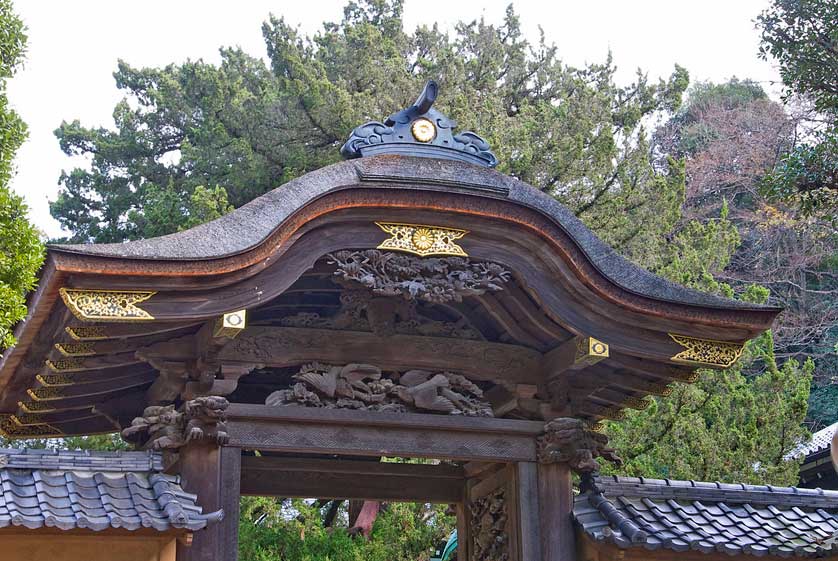
The Karamom, a Chinese style gate to the Shariden, Engakuji Temple, Kamakura, Kanagawa Prefecture
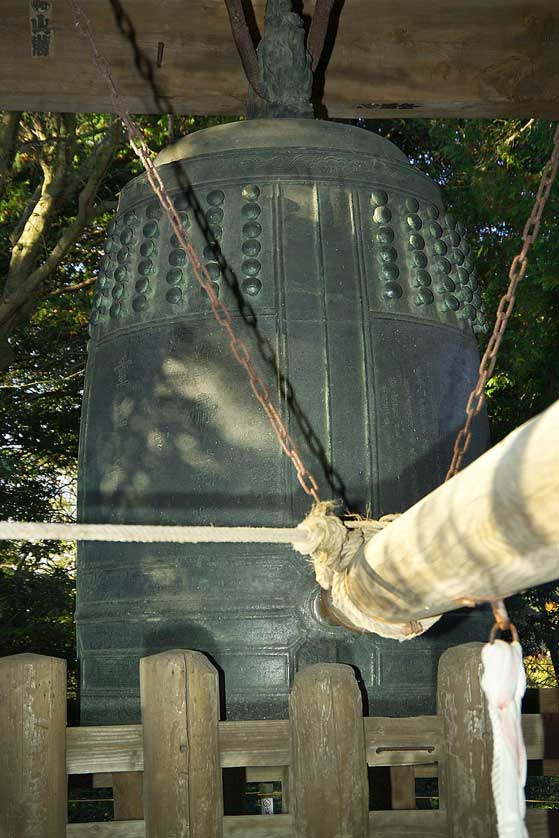
The Great Bell or O-gane at Engakuji Temple, Kamakura, Kanagawa Prefecture
Zen practices and visitor experiences
Engakuji is not just a historical site but a living center of Zen Buddhism. The temple offers various opportunities for visitors to engage with Zen practices:
Zazen meditation sessions are held regularly, allowing both beginners and experienced practitioners to partake in this fundamental Zen practice. These sessions typically take place in the early morning, offering a serene start to the day. Visitors can join zazen-kai (meditation gatherings) at the Butsuden or Kojirin buildings, experiencing firsthand the mental clarity and focus that Zen meditation cultivates.
For those interested in a more immersive experience, Engakuji occasionally offers longer retreats and intensive meditation periods. These programs provide deeper insights into Zen philosophy and practice, often including teachings from resident monks.
The temple also hosts sutra copying sessions, where visitors can engage in the meditative practice of transcribing Buddhist texts. This activity, known as shakyo, is believed to help focus the mind and cultivate a deeper understanding of Buddhist teachings.
For a taste of traditional Japanese culture, visitors can participate in tea ceremonies held at the temple's tea house. Here, you can savor a cup of Japanese green tea while contemplating the serene surroundings, embodying the Zen principle of finding enlightenment in everyday activities.
Seasonal highlights and events
Engakuji Temple is a year-round destination, with each season offering its own unique charm and special events:
Spring brings the beauty of cherry blossoms to the temple grounds, creating a picturesque setting for contemplation and photography. The temple often hosts special viewing events during this time.
In summer, visitors can enjoy the lush greenery that surrounds the temple buildings. The temple's annual Summer Lecture Series, typically held in late July, offers in-depth teachings on Zen philosophy and practice.
Autumn is perhaps the most popular time to visit Engakuji, as the temple grounds become a canvas of vibrant red and gold foliage. The maple trees near the temple entrance are particularly famous, drawing crowds of visitors in early December for momijigari (autumn leaf viewing).
Winter offers a serene, sometimes snow-covered landscape that perfectly complements the temple's austere architecture. The New Year's ceremonies held at Engakuji are particularly significant, with many locals visiting to start the year with prayer and reflection.
Throughout the year, Engakuji hosts various Buddhist ceremonies and events, such as the Nehane (Nirvana Day) in February, the Gotane (Buddha's Birthday) in April, and the Jodoe (Buddha's Enlightenment Day) in December. These events offer visitors a chance to witness and participate in traditional Buddhist rituals.
Practical information for visitors
When planning your visit to Engakuji Temple, keep the following information in mind:
Location and Access: Engakuji is conveniently located just a one-minute walk from Kita-Kamakura Station on the JR Yokosuka Line. This makes it easily accessible from both Tokyo and Yokohama.
Engakuji Temple Hours & Admission: The temple is open daily from 8:30 AM to 4:30 PM (March to November) and 8:30 AM to 4:00 PM (December to February). Admission fees are 500 yen for adults and 200 yen for children.
Guided Tours: While not always available, the temple sometimes offers guided tours in English. Check with the temple office or local tourist information for current availability.
Etiquette: As a place of worship, visitors are expected to behave respectfully. Dress modestly and speak quietly. Photography is generally allowed in outdoor areas, but may be restricted inside buildings.
Facilities: There's a small shop near the entrance selling souvenirs and religious items. A tea house on the grounds offers traditional Japanese sweets and tea.
For the best experience, consider visiting early in the morning to join a zazen session, or plan your visit during one of the temple's special events or ceremonies.
Engakuji's role in Kamakura's cultural landscape
Engakuji Temple plays a crucial role in Kamakura's rich cultural tapestry, standing as a living link between the city's historic past and its vibrant present. As one of the Five Great Zen Temples of Kamakura, it contributes significantly to the city's status as a major center of Japanese Buddhism.
The temple's importance extends beyond its religious functions. It serves as a cultural and educational center, offering various programs that introduce visitors to traditional Japanese arts and practices. These include not only Zen meditation and tea ceremonies but also calligraphy workshops and lectures on Buddhist philosophy.
Engakuji's grounds have also become a popular spot for locals and tourists alike to enjoy seasonal beauty, particularly during cherry blossom season and autumn foliage. This connection to nature reflects the Zen Buddhist principle of finding enlightenment in the natural world.
Moreover, the temple has embraced its role in preserving and sharing Japanese culture with an international audience. Its efforts to offer some programs in English and its participation in cultural exchange initiatives have made it an important stop for those seeking to understand Japanese spirituality and aesthetics.
As Kamakura continues to balance its historical significance with modern development, Engakuji stands as a testament to the enduring relevance of traditional Japanese culture. It offers visitors a chance to step back from the fast pace of contemporary life and connect with centuries-old wisdom, all while enjoying the beauty of one of Japan's most historic cities.
Whether you're a spiritual seeker, a history enthusiast, or simply a curious traveler, a visit to Engakuji Temple offers a profound and memorable glimpse into the heart of Japanese culture. As you walk its ancient grounds, you'll be following in the footsteps of countless monks, samurai, and pilgrims who have sought wisdom and peace within its walls for over seven centuries.
